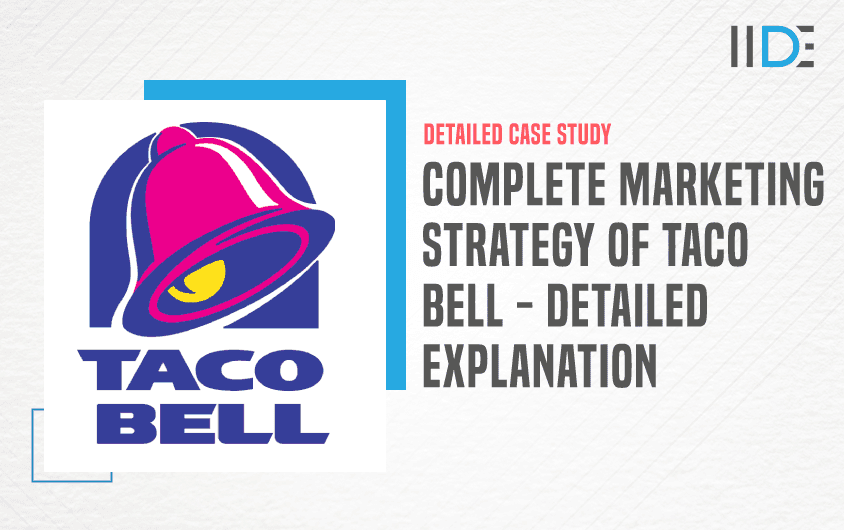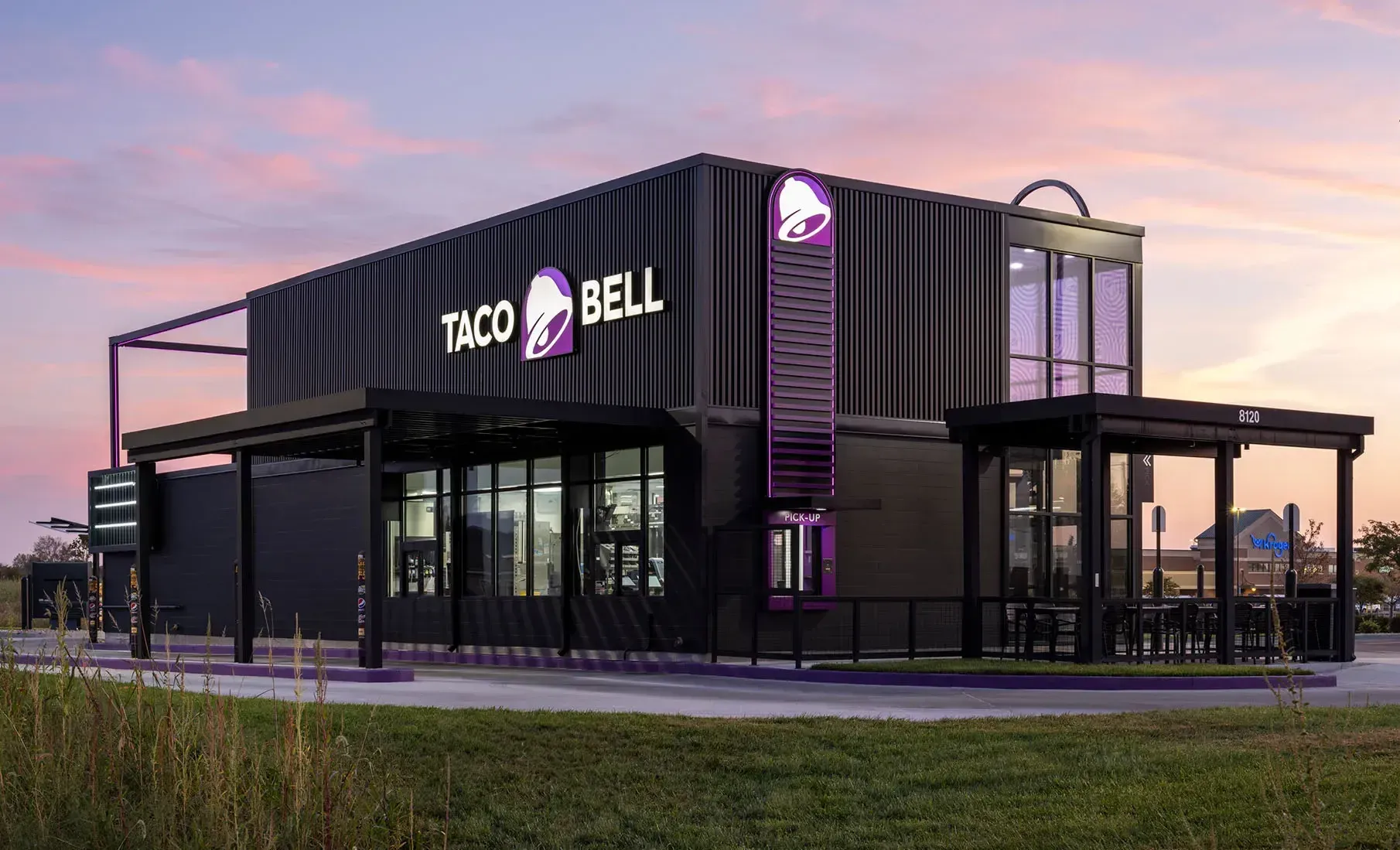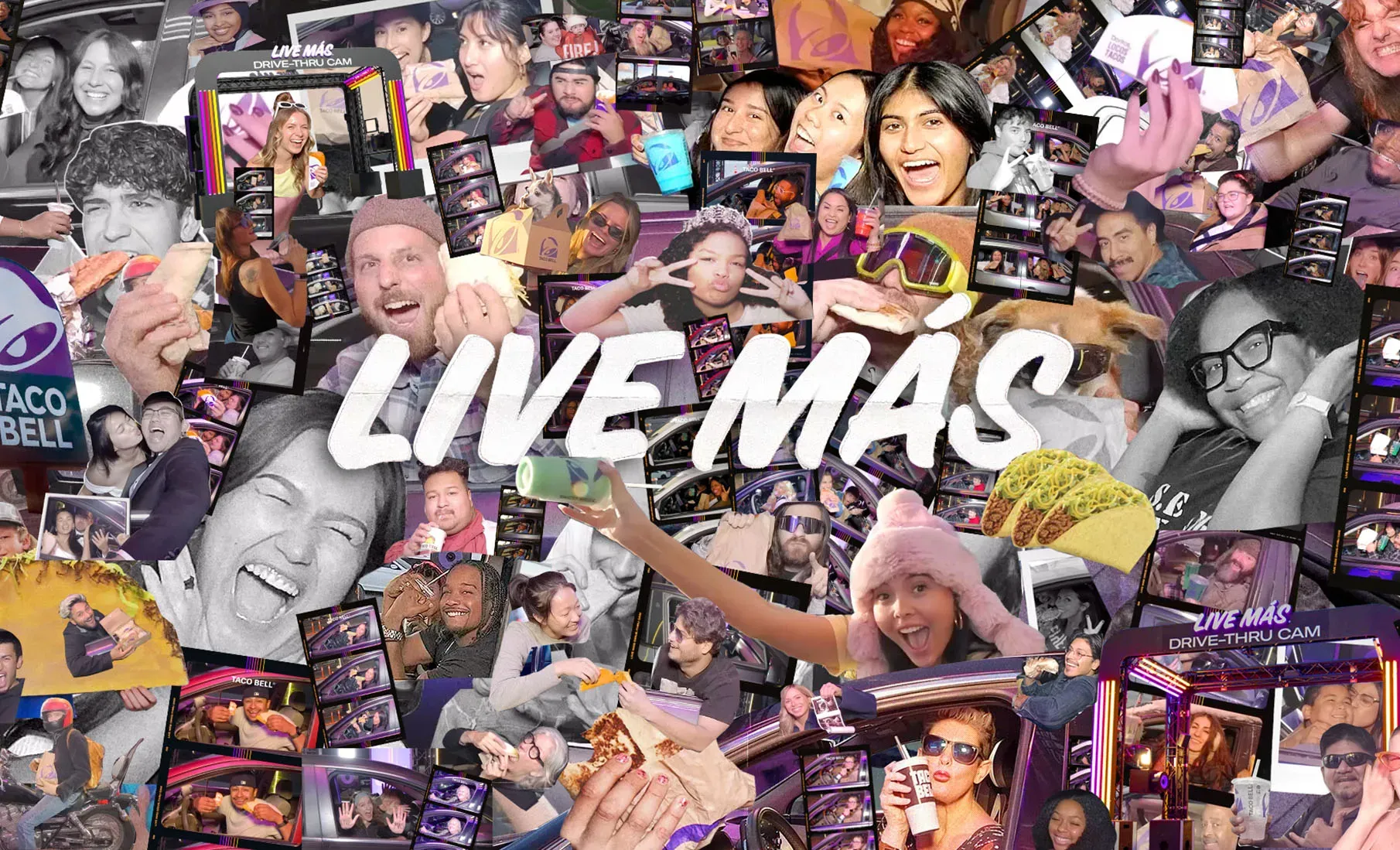
Updated on Dec 12, 2025
Share on:
Taco Bell’s marketing strategy prominently utilizes SEO, social media marketing, paid ads, and influencer partnerships to engage Gen Z and increase brand visibility. The brand also educates its audience on the importance of fast, affordable meals for busy lifestyles, positioning its menu as the solution for quick, tasty, and budget-friendly dining options.
About Taco Bell

(The Founder of Taco Bell – Glen Bell, Source: Taco Bell)
Taco Bell, founded by Glen Bell in 1962, has become one of the most popular quick-service restaurant chains globally, known for its Mexican-inspired cuisine like tacos, burritos, and quesadillas. Taco Bell operates over 7,000 locations worldwide, with a strong presence in North America, Asia, and Oceania.
After becoming a subsidiary of Yum! Brands, Taco Bell has expanded its menu and marketing to cater to younger, health-conscious consumers. Their mission is to serve affordable, fast, and innovative food while keeping up with evolving market demands.
2025 Vision: Taco Bell announces its business growth plan, R.I.N.G The Bell: Relentlessly Innovative Next-Generation Growth.



Learn Digital Marketing for FREE


Marketing Objective or Business Challenge
Taco Bell’s marketing strategy aims to strengthen its position as a market leader in the fast-food industry. The brand faced several challenges, including fierce competition from McDonald’s, Wendy’s, and KFC, as well as the need to cater to shifting consumer preferences towards healthier fast food options.
In 2025, Taco Bell set out to engage a younger, tech-savvy demographic while increasing brand loyalty through social media, influencer partnerships, and innovative menu options.
Their key marketing objectives focus on enhancing customer engagement, increasing brand recall, and pushing for greater adoption of their mobile app for ordering.
Buyers Persona:

Riya Singh
Mumbai
Occupation: Student
Age: 20 years
Motivation
- Affordable and tasty fast food
- Convenience and quick service
- Variety in flavours
- Late-night and on-the-go dining
Interest & Hobbies
- Socialising with peers
- Following pop culture trends
- Late-night entertainment
- Exploring diverse cuisines
Pain Points
Social Media Presence
Marketing Channels Used by Taco Bell
Taco Bell’s primary marketing channel in 2025 is digital, utilising platforms like Instagram, Twitter, Facebook, and its own mobile app.
SEO (Search Engine Optimisation)
Taco Bell places a significant focus on SEO to increase its organic visibility and drive traffic to its website. In 2025, SEO strategies are more sophisticated, focusing on:
- Keyword Strategy:
Taco Bell targets both short-tail and long-tail keywords related to fast food, tacos, and Mexican-inspired cuisine, ensuring its site ranks highly on Google’s search results.
The focus is on both branded keywords (like “Taco Bell” and “Taco Bell near me”) and non-branded keywords (like “best tacos near me” or “healthy fast food options”).
- Content Optimisation:
Taco Bell optimises its content by regularly updating its blog posts, recipes, and news articles, ensuring that these pages are optimised for search engines.
This content strategy aims to rank high for relevant queries related to fast food, new menu items, and food promotions, while also targeting local SEO to make it easy for users to find nearby Taco Bell locations.
- Mobile Optimisation:
Given the growing reliance on smartphones, Taco Bell’s website and ordering systems are optimised for mobile, ensuring quick access to menus, promotions, and store locators on users’ mobile devices.
This approach ensures that mobile users have the best experience when searching for Taco Bell on the go.
Impact: Taco Bell's SEO efforts help boost organic traffic, and drive awareness of Taco Bell’s digital presence and menu offerings, contributing to higher in-store footfall, delivery orders, and app downloads.
Paid Ads (SEM - Search Engine Marketing)
Taco Bell invests heavily in paid search through platforms like Google Ads and social media. Taco Bell’s SEM strategy in 2025 focuses on:
- Google Ads:
Taco Bell uses paid search campaigns to appear in the top positions for relevant fast food keywords. Their campaigns target people searching for specific fast-food items, meal deals, or delivery options.
Taco Bell also runs display ads to retarget visitors who have previously interacted with the brand, pushing them towards ordering or engaging with Taco Bell again.
- Social Media Ads:
Taco Bell runs paid campaigns on Instagram, Facebook, and Twitter to boost awareness of new products or limited-time offers. The brand leverages dynamic social media ads targeting specific user groups based on their interests, behaviors, and demographics.
For example, ads promoting vegetarian menu items target health-conscious audiences, while promotions related to late-night food are aimed at younger, night-owl customers.
- YouTube Ads:
Taco Bell also leverages YouTube ads, particularly with influencer collaborations and high-impact commercials.
YouTube ads are tailored to Gen Z and Millennial audiences who prefer video content, with Taco Bell showcasing vibrant, engaging content related to food trends, pop culture, and their core menu items.
Impact: Paid ads help Taco Bell maintain visibility in a crowded market, ensuring the brand reaches a wide audience and drives more customers to its physical locations, website, and mobile app for easy ordering.
Social Media Marketing
Social media marketing remains one of Taco Bell’s most important strategies, particularly on Instagram, Twitter, Facebook, and TikTok. Taco Bell’s social media strategy in 2025 emphasises:
- Engaging Content:
Taco Bell continues to build on its reputation for fun, quirky, and sometimes irreverent social media posts.
Content includes memes, playful videos, behind-the-scenes glimpses, and visually appealing shots of new or popular menu items.
By tapping into meme culture, Taco Bell makes its brand more relatable and engaging to younger consumers.
- New Product Launches and Promotions:
Taco Bell uses social media to promote new menu items, collaborations, or promotions.
For example, Taco Bell posts mouth-watering images and short videos showcasing new tacos or specialty items, encouraging followers to try them out.
These posts often feature a clear call-to-action, such as visiting a nearby store, ordering through the app, or participating in a limited-time offer.
- User-Generated Content (UGC):
Taco Bell actively encourages customers to share their experiences on social media.
They engage with UGC by reposting customer photos and videos of their Taco Bell meals, often running campaigns where fans can use branded hashtags like #TacoBellLovers to get featured.
This not only increases engagement but also builds a sense of community around the brand.
Impact: Taco Bell’s fun and relatable social media strategy builds a deep connection with its younger audience, amplifies brand awareness, and increases social engagement. The brand also capitalises on user-generated content, which fosters loyalty and provides social proof.
Influencer Marketing
Influencer marketing is another cornerstone of Taco Bell’s marketing efforts in 2025. Taco Bell has been increasingly collaborating with macro and micro-influencers to expand their reach, particularly among Gen Z and Millennial audiences. Taco Bell's influencer marketing strategy includes:
- Gaming Influencers:
Taco Bell has a strong relationship with gaming communities, partnering with well-known gaming influencers, streamers, and eSports teams.
Taco Bell creates campaigns like #GameForTheCheese or #TacoBellXGame, where influencers encourage their audiences to engage with Taco Bell’s products.
These campaigns are often tied to limited-time promotions, such as exclusive in-game rewards or custom meal deals.
- Celebrity Endorsements:
Taco Bell also partners with celebrities, both in the entertainment and sports sectors, to amplify its brand.
Taco Bell has worked with figures like Avneet Kaur and Hardik Pandya for influencer-driven campaigns.
These influencers promote Taco Bell’s new offerings or limited-time meals to a large and loyal fan base.
- Food & Lifestyle Influencers:
Taco Bell works with food bloggers, lifestyle influencers, and TikTok creators who create engaging and entertaining content around Taco Bell’s menu items.
These influencers often create recipes, reviews, and unboxing-style content, giving Taco Bell an authentic voice among their follower base.
Impact: Influencer marketing has allowed Taco Bell to reach younger, digitally-savvy audiences in a way that feels more authentic and personal. This approach has proven highly effective in creating buzz, driving engagement, and ultimately increasing sales through influencer-driven campaigns.
Mobile App Marketing
Taco Bell has significantly optimised its mobile app experience, making it one of the central pillars of its marketing strategy. In 2025, Taco Bell continues to innovate in app-based marketing through:
- Exclusive Offers:
Taco Bell incentivises app downloads and usage with exclusive discounts, deals, and rewards for app users.
Taco Bell users can earn loyalty points with every order, which can be redeemed for free food, making it a key tool in driving customer retention.
- Personalization:
The app provides personalised recommendations based on order history, dietary preferences, and previous interactions.
Taco Bell uses this data to suggest new menu items and promotional offers, further increasing the likelihood of repeat orders.
- Efficient Ordering:
The app makes ordering fast and convenient, allowing users to skip long lines, customize their orders, and select pickup or delivery options.
Taco Bell’s app is especially popular among college students and busy professionals who prioritize speed and convenience.
- Push Notifications:
Taco Bell uses push notifications to send timely updates about new menu items, limited-time promotions, or order status, keeping users engaged and informed in real-time.
Impact: Taco Bell’s app has become a key driver for both customer loyalty and sales. It enhances convenience, encourages repeat orders, and strengthens Taco Bell’s direct connection with consumers.
The marketing strategy of McDonald’s highlights how fast food giants leverage consistency and local adaptation, which mirrors many of Taco Bell’s approaches.
Taco Bell Marketing Strategy Breakdown
Digital Marketing
SEO Performance:
- Website Traffic: As of June 2025, Tacobell received approximately 11.9 million visits, with an average session duration of 6 minutes and 45 seconds.
- Organic Search Traffic: The site garnered 11.9 million visits from organic search, accounting for 37.36% of its traffic.
Data as per Semrush

Paid Advertising:
- Ad Spend: Taco Bell invested over $100 million in advertising across digital, print, and national TV in the past year.
- Campaigns: The brand launched and advertised 27 new products, utilising premium ad units across over 100 different media properties.
- Paid Search Traffic: Paid search efforts have increased by 49.65%, resulting in 856.6K visits, demonstrating a strategic investment in paid advertising.
Data as per MEDIARadar
Social Media Strategy:
Platform Engagement: Taco Bell maintains a strong presence on platforms like Instagram, Twitter, and TikTok, utilising a playful and meme-centric approach to engage younger audiences.
Campaigns: Notable campaigns include #BeOneWithGame and #GameForTheCheese, which resonate with Gen Z consumers.
Big Game Ad: In February 2025, Taco Bell's Big Game commercial featured nearly 400 real fans sharing authentic moments, such as pregnancy announcements and anniversaries, instead of relying solely on celebrities.

Content Strategy
Campaigns & Timelines
#BeOneWithGame: A campaign that integrated gaming culture with Taco Bell's offerings, appealing to the gaming community.
#GameForTheCheese: Focused on the brand's cheesy menu items, leveraging humour and relatability to engage audiences.
User-Generated Content:
Encouragement: Taco Bell actively encourages customers to share their experiences using branded hashtags, fostering community engagement.
Contests: Regular social media contests incentivise participation and content creation from fans.
Influencer Partnerships
Collaborations:
Celebrity Endorsements: Taco Bell has partnered with celebrities such as Doja Cat and LeBron James to promote specific menu items and campaigns.
Influencer Engagement: The brand collaborates with a diverse range of influencers, from macro to micro, to reach various audience segments.
Campaigns:
Mexican Pizza: The Musical: A creative campaign that combined music and food, featuring influencer participation and viral content.
App Redirection Strategy
#OnlyInTheApp Campaign:
Social Media Strategy: Taco Bell executed a campaign where their social media channels featured a single post with the hashtag #OnlyInTheApp, directing followers to download the Taco Bell app for exclusive deals.
App Features: The app offers features like mobile ordering, exclusive promotions, and a rewards program to enhance customer loyalty.
Results & Impact
- Taco Bell’s global sales reached $5.65 billion in 2025, driven by a 10% increase in online orders through the app and delivery services.
- The brand’s digital presence grew substantially, with over 100k monthly visits, largely fueled by successful SEO and content marketing strategies.
- Taco Bell's social media engagement saw a 3x increase from influencer campaigns and interactive social posts.
- Taco Bell's website ranked in the top 3 for keywords such as "best taco fast food" and "affordable fast food," resulting in significant organic traffic.
- The brand’s influencer campaigns led to a 25% increase in followers across Instagram and Twitter, directly contributing to brand awareness.
Starbucks marketing strategy highlights how brand consistency and experiential marketing play a crucial role in customer retention.
What Worked & Why
Taco Bell's emphasis on influencer marketing and digital engagement played a pivotal role in its 2025 success.
The brand’s partnerships with gaming influencers and social media content aligned perfectly with its target audience, boosting brand visibility and engagement.
Their innovative approach to content, like collaborating with celebrities and launching engaging contests, proved to be a powerful tool in driving user interaction.
The strategy resonated with Taco Bell's younger demographic, who are active on social media and value authenticity and creativity in campaigns.
The brand’s ability to stay current with trends like gaming and meme culture strengthened its connection with the audience.
What Didn’t Work & Why
Some campaigns, such as the “Naked Egg Taco” and “Waffle Taco,” faced backlash and underperformed as expected. The brand’s initial attempt at breakfast items did not appeal to their core customers, leading to a poor response.
The failure was largely due to misalignment with consumer expectations, as Taco Bell’s audience wasn’t seeking overly experimental breakfast options. Despite Taco Bell’s strong brand identity in lunch and dinner offerings, the breakfast menu lacked clear differentiation and failed to offer compelling value.
Lessons Learned: Taco Bell learned the importance of customer feedback and fine-tuning product offerings to align with its audience's core preferences. It highlighted the need for gradual innovation and market testing before a full rollout.
Marketing strategy of Jollibee demonstrates how cultural relevance and local tastes can be pivotal for international food chains.
IIDE Student Recommendations: Key Areas for Brand Improvement
1. Expand SEO Strategy with Long-Tail Keywords
Current Issue: Taco Bell’s current SEO strategy focuses on broad keywords like “best tacos near me.”
Recommendation: Expand focus to long-tail keywords, such as:
- “affordable late-night tacos”
- “vegan taco options near me”
- “healthy fast food near me”
Impact: Targeting niche, lower-competition keywords will help Taco Bell attract more qualified traffic and boost organic rankings.
2. Enhance Mobile App Experience
Current Issue: While Taco Bell’s app provides useful features like exclusive deals, it could improve its mobile user experience.
Recommendation:
- Implement one-tap checkouts
- Improve page speed
- Introduce Voice Search and WhatsApp support to enhance usability.
Impact: These improvements will boost customer retention and enhance user experience, leading to more frequent usage of the app.
3. Broaden Global Expansion Strategy
Current Issue: Taco Bell’s international presence is still growing, and their menu may not resonate in all global markets.
Recommendation:
- Localise menus and marketing efforts based on regional tastes and preferences.
- Focus on markets like Southeast Asia, where fast-casual dining is growing rapidly.
Impact: This approach will help Taco Bell increase its market share in international markets and strengthen brand presence globally.
4. Launch a Loyalty or Referral Program
Current Issue: Taco Bell lacks a formal loyalty or referral program, which is essential for customer retention.
Recommendation:
Introduce a loyalty program with benefits like birthday discounts, early access to new products, and a referral program.
Impact: This strategy will increase customer engagement, promote repeat purchases, and boost brand loyalty.
5. Invest in Rich Media Content
Current Issue: Taco Bell could further enhance brand visibility through more engaging content.
Recommendation:
- Create a library of video content such as product demos, customer testimonials, and how-to videos.
- Embed this content on Taco Bell’s website and across its social media channels.
Impact: Rich media content will build brand trust, increase engagement, and help improve SEO by increasing time on site.
6. Experiment with Offline Retail Collaborations
Current Issue: Taco Bell’s online presence is strong, but offline visibility can further enhance trust.
Recommendation:
Experiment with offline retail collaborations such as pop-up shops, kiosks, or school partnerships to give customers a hands-on product experience.
Impact: This will increase brand visibility, build trust, and create real-world engagement with consumers, especially in new markets.
7. Smarter Email Marketing
Current Issue: Taco Bell can improve its email marketing strategy by targeting customers based on their preferences.
Recommendation:
- Use personalization based on customer data (e.g., child’s age, previous purchases, browsing behavior).
- Run campaigns like “It’s time to upgrade your taco order!” or exclusive previews of new menu items.
Impact: This will help nurture leads, increase repeat purchases, and boost customer retention.
8. Utilize Data Analytics for Customer Segmentation
Current Issue: Taco Bell may not be fully capitalizing on customer insights to improve its marketing efforts.
Recommendation:
- Implement data analytics tools to better understand customer behavior.
- Segment the audience based on interests and purchasing patterns.
Impact: This will enable Taco Bell to create more targeted campaigns, improving marketing effectiveness and customer satisfaction.
9. Enhance Customer Support with AI Chatbots
Current Issue: Taco Bell can improve its customer service to enhance the user experience.
Recommendation:
- Implement AI-driven chatbots for 24/7 customer support, helping customers get instant answers to their queries.
Impact: This will reduce bounce rates, improve customer experience, and increase conversion rates.
10. Leverage User-Generated Content
Current Issue: Taco Bell could further leverage its community to build brand loyalty.
Recommendation:
- Actively encourage customers to share their experiences on social media by using branded hashtags like #TacoBellLovers.
- Repost UGC from customers to amplify brand engagement.
Impact: This will foster a stronger sense of community, act as social proof, and increase brand loyalty.
Marketing strategy of Dunkin Donuts shows how a breakfast-first positioning can help build brand loyalty in the QSR segment.
Want to Know Why 5,00,000+ Students Trust Us?
Dive into the numbers that make us the #1 choice for career success

MBA - Level
Best For
Fresh Graduates
Mode of Learning
On Campus (Mumbai & Delhi)
Starts from
Mar 1, 2026
Duration
11 Months
Live & Online
Best For
Working Professionals
Mode of Learning
Online
Starts from
Jan 23, 2026
Duration
4-6 Months

Online
Best For
AI Enthusiasts
Mode of Learning
Online
Duration
5 Months

Offline
Best For
12th Passouts
Mode of Learning
On Campus (Mumbai)
Duration
3 Years
Recent Post
Aditya Shastri leads the Business Development segment at IIDE and is a seasoned Content Marketing expert. With over a decade of experience, Aditya has trained more than 20,000 students and professionals in digital marketing, collaborating with prestigious institutions and corporations such as Jet Airways, Godrej Professionals, Pfizer, Mahindra Group, Publicis Worldwide, and many others. His ability to simplify complex marketing concepts, combined with his engaging teaching style, has earned him widespread admiration from students and professionals alike.
Aditya has spearheaded IIDE’s B2B growth, forging partnerships with over 40 higher education institutions across India to upskill students in digital marketing and business skills. As a visiting faculty member at top institutions like IIT Bhilai, Mithibai College, Amity University, and SRCC, he continues to influence the next generation of marketers.
Apart from his marketing expertise, Aditya is also a spiritual speaker, often traveling internationally to share insights on spirituality. His unique blend of digital marketing proficiency and spiritual wisdom makes him a highly respected figure in both fields.